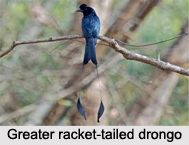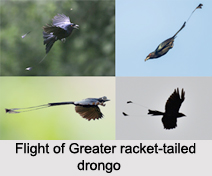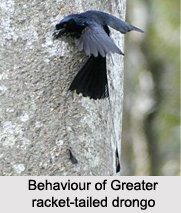 Greater Racket-Tailed Drongo is an Indian bird that bears a scientific name "Dicrurus paradiseus" and is widely distributed in Indian states.
Greater Racket-Tailed Drongo is an Indian bird that bears a scientific name "Dicrurus paradiseus" and is widely distributed in Indian states.
Family of Greater Racket-Tailed Drongo
Greater Racket-Tailed Drongo is a medium-sized Asian bird which is distinctive in having elongated outer tail feathers with webbing restricted to the tips. They are placed along with other drongos in the family Dicruridae.
Habitats of Greater Racket-Tailed Drongo
Greater Racket-Tailed Drongo is conspicuous in the forest habitats often perching in the open and by attracting attention with a wide range of loud calls that include perfect imitations of many other birds. It has been suggested that these imitations may help in the formation of mixed-species foraging flocks, a feature seen in forest bird communities where many insect feeders forage together.
Feeding of Greater Racket-Tailed Drongo
Greater Racket-Tailed Drongo sometimes steals insect prey caught or disturbed by other foragers in the flock. They are diurnal but are active well before dawn and late at dusk. Owing to their widespread distribution and distinctive regional variation, they have become iconic examples of speciation by isolation and genetic drift.
Structure of Greater Racket-Tailed Drongo
In most of its range in Asia, Greater Racket-Tailed Drongo is the largest of the drongo species and is readily identifiable by the distinctive tail rackets and the crest of curled feather that begin in front of the face above the beak and along the crown to varying extents according to the subspecies. The tail with twirled rackets is distinctive and in flight it can appear as if two large bees were chasing a black bird. In the eastern Himalayas the species can be confused with the Lesser Racket-Tailed Drongo, however the latter has flat rackets with the crest nearly absent.
In the eastern Himalayas the species can be confused with the Lesser Racket-Tailed Drongo, however the latter has flat rackets with the crest nearly absent.
Population of Greater Racket-Tailed Drongo
Greater Racket-Tailed Drongo is a widespread species that includes populations that have distinct variations and several subspecies have been named. The nominate form is found in southern India, mainly in forested areas of the Western Ghats Mountain Range in India and the adjoining hill forests of Indian states. The subspecies in Sri Lanka is ceylonicus and is similar to the nominate form but slightly smaller. The subspecies found along the Himalayas is grandis and is the largest and has long glossy neck hackles. The Andaman and Nicobar Islands form otiosus that has shorter neck hackles and the crest is highly reduced while the Nicobar Islands form nicobariensis has a longer frontal crest and with smaller neck hackles than otiosus. The Sri Lanka Drongo D. Lophorinus is used to be treated as a subspecies due to the suggestion that it formed hybrids with ceylonicus and is considered a separate species in newer taxonomic treatments on the basis of their overlapping ranges. Specimens of the nominate form have sometimes been confused with lophorinus. Considerable variation in shape of the bill, extent of the crest, hackles and tail rackets exists in the island populations of Southeast Asia.
Behaviour of Young Greater Racket-Tailed Drongo
The young Greater Racket-Tailed Drongo birds are duller, and can lack a crest while moulting birds can lack the elongate tail streamers. The racket is formed by the inner web of the vane but appears to be on the outer web since the rachis has a twist just above the spatula.
Distribution Range of Greater Racket-Tailed Drongo
The distribution range of Greater Racket-Tailed Drongo extends from the western Himalayas to the eastern Himalayan Mountain Range and Mishmi Hills in the foothills below 4000 feet. They are found in the hills of peninsular India and the Western Ghats Mountain Range in India.
Call of Greater Racket-Tailed Drongo
The call of Greater Racket-Tailed Drongo are extremely varied and include monotonously repeated whistles, metallic and nasal sounds as well as more complex notes and imitations of other birds. They begin calling from as early as 4 am in moonlight often with a metallic tunk-tunk-tunk series. They have an ability to accurately mimic alarm calls of other birds that are learnt through interactions in mixed-species flocks. This is quite unusual, as avian vocal mimicry has hitherto been believed to be ignorant of the original context of the imitated vocalization. African grey parrots are known to use imitated human speech in correct context, but do not show this behaviour in nature. This drongo`s context-sensitive use of other species` alarm calls is thus analogous to a human learning useful short phrases and exclamations in a number of foreign languages.



















